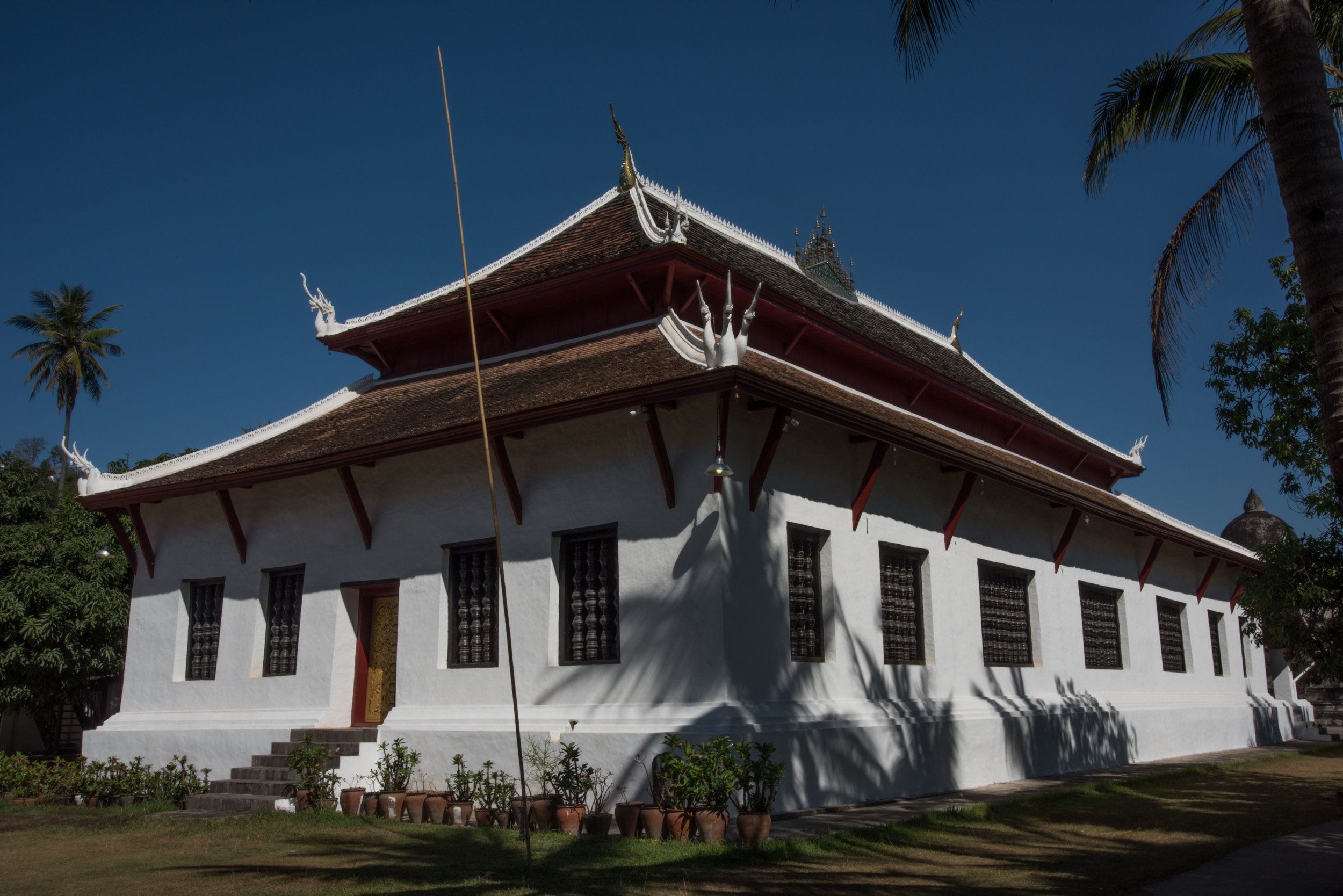The city of Luang Prabang is located on a compact peninsula formed by the confluence of the Mekong River and one of its tributaries, the Nam Khan River.
Luang Prabang was the former royal capital of Laos established in 1353 by Prince Fa Ngum. At that time he named it Lan Xang Hom Khao meaning the Kingdom of a Million Elephants and a White Parasol.
Although the country’s administrative capital was moved to Vientiane in 1545, Lao royalty continued to reside here in Luang Prabang until the Communist takeover in 1975.
Over the next ten to twenty years the city was plunged into desolation as business people, academics and royalty fled the regime. It was only after the demise of the communist Bloc in the 1990s that Luang Prabang reopened to the world and has now become a city of such prominence that it now designated as having World Heritage status.
At 08:30 we met Pheng, our new guide for the Luang Prabang section of our visit to Laos. He directed us to our first stop, the National Museum Complex which was formerly the Royal Palace.
Within the complex we firstly visited the Wat Ho Pha Bang temple which houses the most sacred of Luang Prabang’s religious icons, namely a 1st century solid golden Buddha about 30 cm tall. The Wat Ho Pha Bang temple was built specifically by King Sisavang Vatthana to house this icon in 1969.
The main museum was constructed in the early 1900s as a palace for King Sisavang Vong who reigned from 1904 – 1959.
The exhibits inside are very well presented and commence with the King’s reception room which has splendid murals done by the French artist Alex De Fuatereau in the 1930s.
The throne room is very impressive with red walls covered with mosaics depicting Lao rural life. There are also private quarters such as bedrooms, a music room, library and a display room showing gifts to the king from various countries. Australia’s gifts from former Prime Minister Harold Holt were an opal inlaid silver box and a boomerang. The king’s bedroom was separate from the queen’s adjacent bedroom so that he could entertain his seven favourite concubines without disturbing his wife! A huge statue of King Sisavang Vong is in the garden near the front entrance to the palace complex and even in this day and age people are still leaving offerings to the king at the base of his statue.
Behind the main palace building was a rather decrepit building referred to as the royal garage. The former king’s cars on display were two Lincoln Continentals, an Edsel, a Citroen and a short wheel-based 1980s Toyota Landcruiser. In addition there was a very tattered looking 4.5 m “speed-boat” of 1960s design that was powered by an ancient 35 HP Johnson outboard motor that was now very rusty.
We then visited the nearby Wat Xieng Thong which had elaborate gilded pillars and a large seated golden Buddha plus many smaller Buddhist icons. Pheng explained the 4 elements of a temple or ‘Wat’. They are Sim – the monk house; Kuti – general place for meals, school etc; That – the stupa; and Hor Kong – the drum house.
Perhaps the most interesting pagoda for the morning was Wat Aham Outamathany. This temple was built of wood in Chinese style in 1504. The wood was covered in Lao plaster made of sticky rice, sugar cane, clay and water. It had amongst other things, incredibly gory murals depicting the fate of those who disobey the Buddhist’s five basic commandments; those being to not kill, steal, lie, drink alcohol or commit adultery. Some are deemed acceptable provided that you seek an apology from Buddha.
We had a light lunch in a small café on the banks of the Mekong and then drove for about fifty minutes south-west of Luang Prabang to visit the Tat Kouang Si Waterfalls.
At the start of the waterfall track there is a sanctuary where orphaned Asiatic black moon bears and one Malaysian sun bear are being raised. Their mothers have presumably been killed in order to supply the Chinese market with bears’ bile which is thought to have miraculous medical curative properties.
A further distance up this pathway we encountered the Tat Kouang Si Waterfalls that are unbelievably grandiose and spectacular. There are numerous small waterfalls with azure pools at their bases and further up the river is a 63 m main waterfall. All the way down this impressive sequence of cascades, the water gushes over limestone boulders and splits into smaller waterfalls that continue over three distinct sections covering 300 m. This is very reminiscent of the magnificent Plitvice Lakes waterfalls we’d encountered in Croatia last year.
On our way home from the waterfalls we visited a Lowlands ethnic minority village where cotton spinning and weaving were major occupations. A little nearer Luang Prabang we stopped at a Hmong village where children as young as four were amongst the marketeers trying to convince us to buy purses, scarves, table cloths and the like.
For our evening meal we had a very nice dinner plus French wines at the Elephant Restaurant which was only 100 m away from our Villa Santi Hotel.
Tomorrow we have the first half of the day visiting an elephant sanctuary at Manda Lao.













